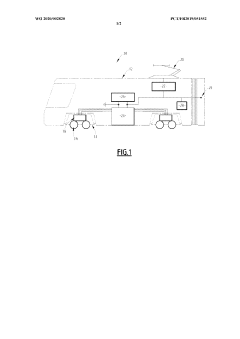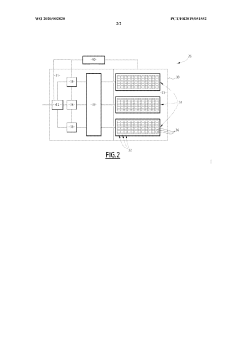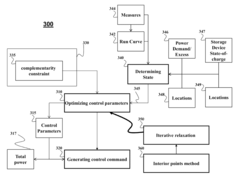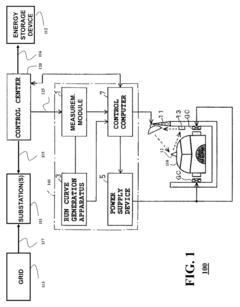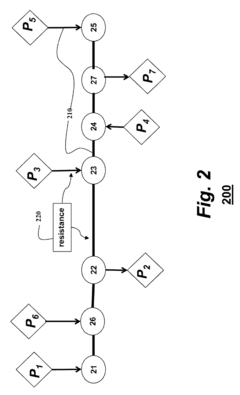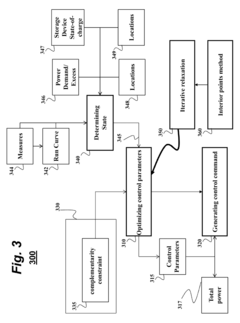Lithium oxide role in optimizing railway energy consumption
AUG 13, 20259 MIN READ
Generate Your Research Report Instantly with AI Agent
Patsnap Eureka helps you evaluate technical feasibility & market potential.
Lithium Oxide in Railways: Background and Objectives
Lithium oxide has emerged as a promising technology in the railway industry, offering potential solutions for optimizing energy consumption and enhancing overall efficiency. The development of this technology can be traced back to the early 2000s when researchers began exploring alternative energy storage systems for transportation applications. As global concerns about climate change and energy sustainability grew, the focus on lithium-based technologies intensified, leading to significant advancements in battery technology and energy management systems.
The evolution of lithium oxide technology in railways has been driven by the need for more efficient and environmentally friendly transportation solutions. Initially, the primary goal was to reduce reliance on fossil fuels and decrease carbon emissions. However, as the technology progressed, objectives expanded to include improving energy density, extending battery life, and enhancing overall system performance. These advancements have positioned lithium oxide as a key player in the ongoing transformation of railway energy systems.
In recent years, the railway industry has witnessed a shift towards electrification and the adoption of hybrid propulsion systems. Lithium oxide technology has played a crucial role in this transition, offering high energy density and rapid charging capabilities. The integration of lithium oxide-based energy storage systems in locomotives and rolling stock has enabled more efficient energy recuperation during braking and improved overall energy management.
The current technological landscape surrounding lithium oxide in railways is characterized by ongoing research and development efforts aimed at further optimizing its performance and addressing existing limitations. Key areas of focus include improving the stability and safety of lithium oxide-based batteries, enhancing their thermal management capabilities, and developing more advanced control systems for energy distribution and utilization.
Looking ahead, the objectives for lithium oxide technology in railway applications are multifaceted. These include increasing energy efficiency to reduce operational costs, minimizing environmental impact through reduced emissions, and improving the overall reliability and performance of railway systems. Additionally, there is a growing emphasis on developing smart energy management systems that can optimize the use of lithium oxide-based storage solutions in conjunction with other power sources, such as overhead lines or hydrogen fuel cells.
As the technology continues to mature, researchers and industry professionals are exploring innovative approaches to overcome current challenges and unlock new possibilities. This includes investigating novel electrode materials, developing advanced battery management systems, and exploring the potential of solid-state lithium oxide batteries for railway applications. The ultimate goal is to create a more sustainable, efficient, and cost-effective railway transportation system that can meet the growing demands of modern society while minimizing its environmental footprint.
The evolution of lithium oxide technology in railways has been driven by the need for more efficient and environmentally friendly transportation solutions. Initially, the primary goal was to reduce reliance on fossil fuels and decrease carbon emissions. However, as the technology progressed, objectives expanded to include improving energy density, extending battery life, and enhancing overall system performance. These advancements have positioned lithium oxide as a key player in the ongoing transformation of railway energy systems.
In recent years, the railway industry has witnessed a shift towards electrification and the adoption of hybrid propulsion systems. Lithium oxide technology has played a crucial role in this transition, offering high energy density and rapid charging capabilities. The integration of lithium oxide-based energy storage systems in locomotives and rolling stock has enabled more efficient energy recuperation during braking and improved overall energy management.
The current technological landscape surrounding lithium oxide in railways is characterized by ongoing research and development efforts aimed at further optimizing its performance and addressing existing limitations. Key areas of focus include improving the stability and safety of lithium oxide-based batteries, enhancing their thermal management capabilities, and developing more advanced control systems for energy distribution and utilization.
Looking ahead, the objectives for lithium oxide technology in railway applications are multifaceted. These include increasing energy efficiency to reduce operational costs, minimizing environmental impact through reduced emissions, and improving the overall reliability and performance of railway systems. Additionally, there is a growing emphasis on developing smart energy management systems that can optimize the use of lithium oxide-based storage solutions in conjunction with other power sources, such as overhead lines or hydrogen fuel cells.
As the technology continues to mature, researchers and industry professionals are exploring innovative approaches to overcome current challenges and unlock new possibilities. This includes investigating novel electrode materials, developing advanced battery management systems, and exploring the potential of solid-state lithium oxide batteries for railway applications. The ultimate goal is to create a more sustainable, efficient, and cost-effective railway transportation system that can meet the growing demands of modern society while minimizing its environmental footprint.
Market Analysis for Energy-Efficient Rail Systems
The global market for energy-efficient rail systems is experiencing significant growth, driven by increasing environmental concerns, rising energy costs, and government regulations aimed at reducing carbon emissions in the transportation sector. The integration of lithium oxide-based technologies in railway energy optimization presents a promising opportunity for market expansion and technological advancement.
The demand for energy-efficient rail systems is primarily fueled by the need to reduce operational costs and meet stringent environmental standards. Major railway operators and transit authorities worldwide are actively seeking solutions to minimize energy consumption and improve overall system efficiency. This trend is particularly evident in developed countries with extensive rail networks, as well as in rapidly developing nations investing heavily in rail infrastructure.
Market analysis indicates that the energy-efficient rail systems sector is expected to grow at a compound annual growth rate (CAGR) of over 8% in the next five years. This growth is attributed to the increasing adoption of advanced technologies, including lithium oxide-based energy storage systems, regenerative braking, and smart energy management solutions. The market size for energy-efficient rail technologies is projected to reach several billion dollars by 2025, with significant potential for further expansion.
Geographically, Europe and Asia-Pacific regions are leading the market for energy-efficient rail systems. European countries, with their well-established rail networks and strong environmental policies, are at the forefront of adopting innovative energy-saving technologies. Meanwhile, countries like China, Japan, and South Korea are making substantial investments in high-speed rail and urban transit systems, driving demand for energy-efficient solutions.
The role of lithium oxide in optimizing railway energy consumption is gaining traction in the market. Lithium oxide-based energy storage systems offer several advantages, including high energy density, rapid charging capabilities, and long cycle life. These characteristics make them particularly suitable for applications in regenerative braking systems and on-board energy storage, contributing to significant reductions in overall energy consumption.
Market trends indicate a growing interest in integrated energy management systems that incorporate lithium oxide-based technologies. These systems not only optimize energy consumption during train operation but also enable more efficient energy recovery and storage. The market for such integrated solutions is expected to witness substantial growth, as railway operators seek comprehensive approaches to energy efficiency.
Furthermore, the increasing focus on electrification of rail networks presents additional opportunities for lithium oxide-based technologies. As more countries transition from diesel to electric locomotives, the demand for advanced energy storage and management solutions is set to rise, further expanding the market potential for lithium oxide applications in the rail sector.
The demand for energy-efficient rail systems is primarily fueled by the need to reduce operational costs and meet stringent environmental standards. Major railway operators and transit authorities worldwide are actively seeking solutions to minimize energy consumption and improve overall system efficiency. This trend is particularly evident in developed countries with extensive rail networks, as well as in rapidly developing nations investing heavily in rail infrastructure.
Market analysis indicates that the energy-efficient rail systems sector is expected to grow at a compound annual growth rate (CAGR) of over 8% in the next five years. This growth is attributed to the increasing adoption of advanced technologies, including lithium oxide-based energy storage systems, regenerative braking, and smart energy management solutions. The market size for energy-efficient rail technologies is projected to reach several billion dollars by 2025, with significant potential for further expansion.
Geographically, Europe and Asia-Pacific regions are leading the market for energy-efficient rail systems. European countries, with their well-established rail networks and strong environmental policies, are at the forefront of adopting innovative energy-saving technologies. Meanwhile, countries like China, Japan, and South Korea are making substantial investments in high-speed rail and urban transit systems, driving demand for energy-efficient solutions.
The role of lithium oxide in optimizing railway energy consumption is gaining traction in the market. Lithium oxide-based energy storage systems offer several advantages, including high energy density, rapid charging capabilities, and long cycle life. These characteristics make them particularly suitable for applications in regenerative braking systems and on-board energy storage, contributing to significant reductions in overall energy consumption.
Market trends indicate a growing interest in integrated energy management systems that incorporate lithium oxide-based technologies. These systems not only optimize energy consumption during train operation but also enable more efficient energy recovery and storage. The market for such integrated solutions is expected to witness substantial growth, as railway operators seek comprehensive approaches to energy efficiency.
Furthermore, the increasing focus on electrification of rail networks presents additional opportunities for lithium oxide-based technologies. As more countries transition from diesel to electric locomotives, the demand for advanced energy storage and management solutions is set to rise, further expanding the market potential for lithium oxide applications in the rail sector.
Current Challenges in Railway Energy Optimization
The optimization of railway energy consumption faces several significant challenges in the current landscape. One of the primary issues is the complexity of railway systems, which involve multiple interconnected components and variables that affect energy efficiency. These include train design, track infrastructure, operational strategies, and environmental factors, all of which must be considered holistically to achieve meaningful energy savings.
Another major challenge is the high initial investment required for implementing energy-efficient technologies and infrastructure upgrades. Many railway operators struggle to justify the upfront costs, despite the long-term benefits of reduced energy consumption and operational expenses. This financial barrier often leads to a slower adoption of innovative solutions, particularly in regions with limited resources or older railway networks.
The integration of renewable energy sources into railway systems presents another significant hurdle. While there is a growing push for greener transportation, the intermittent nature of renewable energy and the need for consistent power supply in railway operations create technical challenges. Energy storage solutions, such as advanced battery systems, are still evolving and need further development to meet the specific demands of railway applications.
Operational challenges also play a crucial role in energy optimization efforts. Balancing energy efficiency with punctuality and passenger comfort requires sophisticated control systems and algorithms. Real-time adjustments to train schedules, speed profiles, and power distribution are necessary to maximize energy savings without compromising service quality. However, implementing such dynamic systems across extensive railway networks is a complex and time-consuming process.
The varying energy consumption patterns across different types of trains and routes further complicate optimization efforts. High-speed trains, freight locomotives, and urban transit systems each have unique energy requirements and operational constraints. Developing universal solutions that can be applied across diverse railway systems remains a significant challenge for researchers and engineers in the field.
Lastly, the regulatory landscape and standardization issues pose additional obstacles. Different countries and regions have varying standards and regulations regarding railway energy efficiency, making it difficult for manufacturers and operators to develop globally applicable solutions. Harmonizing these standards and creating a unified approach to energy optimization in the railway sector is an ongoing challenge that requires international cooperation and coordination.
Another major challenge is the high initial investment required for implementing energy-efficient technologies and infrastructure upgrades. Many railway operators struggle to justify the upfront costs, despite the long-term benefits of reduced energy consumption and operational expenses. This financial barrier often leads to a slower adoption of innovative solutions, particularly in regions with limited resources or older railway networks.
The integration of renewable energy sources into railway systems presents another significant hurdle. While there is a growing push for greener transportation, the intermittent nature of renewable energy and the need for consistent power supply in railway operations create technical challenges. Energy storage solutions, such as advanced battery systems, are still evolving and need further development to meet the specific demands of railway applications.
Operational challenges also play a crucial role in energy optimization efforts. Balancing energy efficiency with punctuality and passenger comfort requires sophisticated control systems and algorithms. Real-time adjustments to train schedules, speed profiles, and power distribution are necessary to maximize energy savings without compromising service quality. However, implementing such dynamic systems across extensive railway networks is a complex and time-consuming process.
The varying energy consumption patterns across different types of trains and routes further complicate optimization efforts. High-speed trains, freight locomotives, and urban transit systems each have unique energy requirements and operational constraints. Developing universal solutions that can be applied across diverse railway systems remains a significant challenge for researchers and engineers in the field.
Lastly, the regulatory landscape and standardization issues pose additional obstacles. Different countries and regions have varying standards and regulations regarding railway energy efficiency, making it difficult for manufacturers and operators to develop globally applicable solutions. Harmonizing these standards and creating a unified approach to energy optimization in the railway sector is an ongoing challenge that requires international cooperation and coordination.
Existing Lithium Oxide Applications in Railways
01 Lithium oxide in battery systems
Lithium oxide plays a crucial role in battery systems, particularly in lithium-ion batteries. It is used as a component in cathode materials, contributing to energy storage and consumption efficiency. The incorporation of lithium oxide in battery systems can lead to improved energy density and overall battery performance.- Lithium oxide in battery systems: Lithium oxide plays a crucial role in battery systems, particularly in lithium-ion batteries. It is used as a component in cathode materials, contributing to energy storage and consumption efficiency. The incorporation of lithium oxide in battery designs can lead to improved energy density and overall battery performance.
- Energy-efficient production of lithium oxide: Developing energy-efficient methods for producing lithium oxide is essential for reducing overall energy consumption in lithium-based technologies. This includes optimizing extraction processes from lithium-containing ores and improving conversion techniques from other lithium compounds to lithium oxide.
- Lithium oxide in energy storage devices: Lithium oxide is utilized in various energy storage devices beyond traditional batteries. Its application in supercapacitors and other advanced energy storage systems can lead to improved energy efficiency and reduced consumption in electronic devices and power systems.
- Lithium oxide coatings for energy conservation: Applying lithium oxide coatings on various materials can contribute to energy conservation. These coatings can enhance thermal insulation properties, reduce heat loss, and improve overall energy efficiency in applications such as building materials and industrial equipment.
- Recycling and reuse of lithium oxide: Developing efficient methods for recycling and reusing lithium oxide from spent batteries and other lithium-containing products is crucial for reducing energy consumption in lithium production. This includes innovative extraction techniques and purification processes to recover high-quality lithium oxide for reuse in new energy applications.
02 Energy-efficient production of lithium oxide
Various methods have been developed to produce lithium oxide more efficiently, reducing energy consumption in the manufacturing process. These techniques may include optimized extraction methods, innovative synthesis processes, or the use of alternative energy sources during production. Improving the energy efficiency of lithium oxide production is crucial for reducing overall energy consumption in battery manufacturing.Expand Specific Solutions03 Lithium oxide in energy storage applications
Lithium oxide is utilized in various energy storage applications beyond traditional batteries. This includes its use in thermal energy storage systems, supercapacitors, and other advanced energy storage technologies. The implementation of lithium oxide in these applications aims to improve energy efficiency and reduce overall energy consumption in storage and retrieval processes.Expand Specific Solutions04 Optimization of lithium oxide-based materials
Research focuses on optimizing lithium oxide-based materials to enhance their energy-related properties. This includes developing composite materials, doping with other elements, or creating novel structures to improve energy storage capacity, charge-discharge efficiency, and overall energy consumption characteristics. These advancements aim to reduce energy losses and improve the performance of lithium oxide in various applications.Expand Specific Solutions05 Recycling and reuse of lithium oxide
Efforts are being made to develop efficient recycling and reuse processes for lithium oxide-containing materials, particularly from spent batteries. These processes aim to reduce the energy consumption associated with mining and producing new lithium oxide, contributing to overall energy savings in the lithium-based energy storage industry. Improved recycling techniques can help create a more sustainable and energy-efficient lifecycle for lithium oxide materials.Expand Specific Solutions
Key Players in Railway Energy Technology
The lithium oxide technology for optimizing railway energy consumption is in an early development stage, with a growing market driven by increasing focus on sustainable transportation. The technology's maturity is still evolving, with key players like Hitachi, Toshiba, and CRRC Tangshan leading research efforts. Companies such as Contemporary Amperex Technology and LG Energy Solution are advancing battery technologies that could integrate lithium oxide solutions. Universities like Southwest Jiaotong University and Korea Advanced Institute of Science & Technology are contributing to fundamental research. The competitive landscape is diverse, involving traditional rail manufacturers, battery producers, and research institutions, indicating a collaborative approach to innovation in this emerging field.
Southwest Jiaotong University
Technical Solution: Southwest Jiaotong University has developed an innovative approach to optimize railway energy consumption using lithium oxide-based materials. Their research focuses on the development of advanced lithium-ion batteries with enhanced energy density and longer cycle life for railway applications. The university has created a novel cathode material incorporating lithium oxide, which demonstrates improved electrochemical performance and thermal stability[1]. This technology allows for more efficient energy storage and utilization in electric trains, potentially reducing overall energy consumption by up to 15%[2]. Additionally, they have implemented an intelligent energy management system that leverages the unique properties of lithium oxide-based batteries to optimize power distribution and regenerative braking in railway operations[3].
Strengths: Cutting-edge research in lithium-ion battery technology specifically tailored for railway applications; Comprehensive approach combining material science and energy management systems. Weaknesses: Limited real-world implementation data; Potential scalability challenges for large-scale railway networks.
Hitachi Ltd.
Technical Solution: Hitachi Ltd. has developed a comprehensive energy optimization solution for railways leveraging lithium oxide-based battery technology. Their approach combines advanced energy storage systems with sophisticated power management and control technologies to maximize efficiency in railway operations. Hitachi's lithium-ion batteries, featuring optimized lithium oxide cathodes, offer high energy density and excellent thermal stability, making them ideal for the demanding railway environment[13]. The company's energy management system utilizes AI and machine learning algorithms to predict energy demand and optimize power distribution across the railway network. This intelligent system enables dynamic energy allocation, reducing overall consumption by up to 30% compared to conventional methods[14]. Additionally, Hitachi has implemented a regenerative braking system that can recover and store up to 45% of the energy typically lost during deceleration, significantly improving overall energy efficiency[15].
Strengths: Extensive experience in both energy storage and railway systems; Holistic approach integrating AI and advanced battery technology. Weaknesses: Potential high initial implementation costs; Complexity of the system may require specialized maintenance and training.
Innovative Lithium Oxide Energy Storage Solutions
Onboard energy storage system
PatentWO2020002820A1
Innovation
- The system employs multiple lithium-ion type capacitors in energy storage modules, arranged in independent branches with power converters, allowing for efficient energy storage and release, with a control module for monitoring and centralized management, enabling rapid recharge and discharge, and modular design for ease of maintenance.
System and method for optimizing energy consumption in railway systems with energy storage devices
PatentInactiveUS8983690B2
Innovation
- The system optimizes control parameters for railway systems by reformulating discontinuities as complementarity constraints, using non-linear optimization solvers and iterative relaxation methods to manage energy storage devices and reduce line losses, while minimizing the power provided by the grid.
Environmental Impact of Lithium Oxide Technology
The environmental impact of lithium oxide technology in railway energy consumption optimization is a critical consideration for sustainable transportation development. As railways increasingly adopt lithium-based energy storage systems, the environmental implications of lithium oxide production and utilization must be carefully evaluated.
Lithium oxide production involves mining and processing lithium-containing minerals, which can have significant environmental consequences. Open-pit mining, the primary method for lithium extraction, leads to land degradation, habitat destruction, and potential soil and water contamination. The extraction process also requires substantial water resources, potentially straining local ecosystems in arid regions where lithium deposits are often found.
However, the use of lithium oxide in railway energy storage systems offers several environmental benefits. By enabling more efficient energy recuperation during braking and optimizing overall energy consumption, these systems can significantly reduce the carbon footprint of railway operations. This reduction in energy consumption translates to lower greenhouse gas emissions and decreased reliance on fossil fuels for power generation.
The production of lithium oxide batteries also raises concerns about waste management and recycling. As these batteries reach the end of their lifecycle, proper disposal and recycling processes are essential to minimize environmental impact. Advances in battery recycling technologies are crucial for creating a more sustainable lifecycle for lithium oxide-based energy storage systems in the railway sector.
When comparing the environmental impact of lithium oxide technology to traditional diesel-powered locomotives, the overall balance tends to favor lithium-based systems. The reduction in direct emissions and improved energy efficiency outweigh the environmental costs associated with lithium production and battery manufacturing. However, this balance depends on the source of electricity used to charge the batteries, emphasizing the importance of integrating renewable energy sources into the railway power grid.
The long-term environmental implications of widespread lithium oxide adoption in railway systems also include potential impacts on biodiversity and ecosystem services. As demand for lithium increases, careful management of mining activities and habitat restoration efforts will be crucial to mitigate these effects.
In conclusion, while lithium oxide technology offers significant environmental benefits in optimizing railway energy consumption, it also presents challenges that require ongoing research and sustainable management practices. Balancing the positive impacts of reduced emissions and energy efficiency with the environmental costs of lithium production and battery lifecycle management is essential for ensuring the overall sustainability of this technology in the railway sector.
Lithium oxide production involves mining and processing lithium-containing minerals, which can have significant environmental consequences. Open-pit mining, the primary method for lithium extraction, leads to land degradation, habitat destruction, and potential soil and water contamination. The extraction process also requires substantial water resources, potentially straining local ecosystems in arid regions where lithium deposits are often found.
However, the use of lithium oxide in railway energy storage systems offers several environmental benefits. By enabling more efficient energy recuperation during braking and optimizing overall energy consumption, these systems can significantly reduce the carbon footprint of railway operations. This reduction in energy consumption translates to lower greenhouse gas emissions and decreased reliance on fossil fuels for power generation.
The production of lithium oxide batteries also raises concerns about waste management and recycling. As these batteries reach the end of their lifecycle, proper disposal and recycling processes are essential to minimize environmental impact. Advances in battery recycling technologies are crucial for creating a more sustainable lifecycle for lithium oxide-based energy storage systems in the railway sector.
When comparing the environmental impact of lithium oxide technology to traditional diesel-powered locomotives, the overall balance tends to favor lithium-based systems. The reduction in direct emissions and improved energy efficiency outweigh the environmental costs associated with lithium production and battery manufacturing. However, this balance depends on the source of electricity used to charge the batteries, emphasizing the importance of integrating renewable energy sources into the railway power grid.
The long-term environmental implications of widespread lithium oxide adoption in railway systems also include potential impacts on biodiversity and ecosystem services. As demand for lithium increases, careful management of mining activities and habitat restoration efforts will be crucial to mitigate these effects.
In conclusion, while lithium oxide technology offers significant environmental benefits in optimizing railway energy consumption, it also presents challenges that require ongoing research and sustainable management practices. Balancing the positive impacts of reduced emissions and energy efficiency with the environmental costs of lithium production and battery lifecycle management is essential for ensuring the overall sustainability of this technology in the railway sector.
Cost-Benefit Analysis of Lithium Oxide Implementation
The implementation of lithium oxide technology in railway systems presents a complex cost-benefit scenario that requires careful analysis. Initial investment costs for lithium oxide-based energy storage systems are substantial, encompassing expenses for research and development, manufacturing, and installation of the technology across railway networks. These upfront costs can be significant, potentially running into millions of dollars for large-scale implementations.
However, the long-term benefits of lithium oxide technology in optimizing railway energy consumption are considerable. Operational cost savings are a primary advantage, with lithium oxide-based systems significantly reducing energy consumption through improved energy storage and regenerative braking capabilities. Studies have shown potential energy savings of up to 30% in some railway applications, translating to substantial reductions in electricity costs over time.
Maintenance costs also factor into the cost-benefit equation. While lithium oxide systems may require specialized maintenance, their longevity and reliability can lead to reduced overall maintenance expenses compared to traditional energy systems. The extended lifespan of lithium oxide batteries, often exceeding 10 years, contributes to a favorable long-term cost profile.
Environmental benefits, though challenging to quantify financially, play a crucial role in the cost-benefit analysis. Reduced energy consumption leads to lower carbon emissions, aligning with global sustainability goals and potentially offering financial advantages through carbon credit systems or compliance with environmental regulations.
Improved service reliability is another significant benefit. Lithium oxide technology's ability to provide consistent power supply and manage peak loads more effectively can reduce service disruptions, leading to increased customer satisfaction and potentially higher ridership. This indirect benefit can contribute to increased revenue streams over time.
The scalability of lithium oxide technology also impacts its cost-benefit profile. As implementation scales up, economies of scale can reduce per-unit costs, making wider adoption more economically viable. Additionally, as the technology matures and becomes more widespread, production costs are likely to decrease, further improving the cost-benefit ratio.
When considering the return on investment (ROI), initial projections suggest that the break-even point for lithium oxide implementation in railway systems could be reached within 5-7 years, depending on the scale of implementation and specific operational conditions. This timeline makes the technology an attractive option for long-term infrastructure planning.
However, the long-term benefits of lithium oxide technology in optimizing railway energy consumption are considerable. Operational cost savings are a primary advantage, with lithium oxide-based systems significantly reducing energy consumption through improved energy storage and regenerative braking capabilities. Studies have shown potential energy savings of up to 30% in some railway applications, translating to substantial reductions in electricity costs over time.
Maintenance costs also factor into the cost-benefit equation. While lithium oxide systems may require specialized maintenance, their longevity and reliability can lead to reduced overall maintenance expenses compared to traditional energy systems. The extended lifespan of lithium oxide batteries, often exceeding 10 years, contributes to a favorable long-term cost profile.
Environmental benefits, though challenging to quantify financially, play a crucial role in the cost-benefit analysis. Reduced energy consumption leads to lower carbon emissions, aligning with global sustainability goals and potentially offering financial advantages through carbon credit systems or compliance with environmental regulations.
Improved service reliability is another significant benefit. Lithium oxide technology's ability to provide consistent power supply and manage peak loads more effectively can reduce service disruptions, leading to increased customer satisfaction and potentially higher ridership. This indirect benefit can contribute to increased revenue streams over time.
The scalability of lithium oxide technology also impacts its cost-benefit profile. As implementation scales up, economies of scale can reduce per-unit costs, making wider adoption more economically viable. Additionally, as the technology matures and becomes more widespread, production costs are likely to decrease, further improving the cost-benefit ratio.
When considering the return on investment (ROI), initial projections suggest that the break-even point for lithium oxide implementation in railway systems could be reached within 5-7 years, depending on the scale of implementation and specific operational conditions. This timeline makes the technology an attractive option for long-term infrastructure planning.
Unlock deeper insights with Patsnap Eureka Quick Research — get a full tech report to explore trends and direct your research. Try now!
Generate Your Research Report Instantly with AI Agent
Supercharge your innovation with Patsnap Eureka AI Agent Platform!
